Plant Profiles
Click on the first letter of the common name of the plant you wish more information about.
A | B | C | D | E | F | G | H | I | J | K | L | M | N | O | P | Q | R | S | T | U | V | W | X | Y | Z
P
- Pagoda Flower
- Pampas Grass
- Parakeet Flower
- Pecan
- Pentas
- Peregrina
- Perennial Peanut
- Persian Shield
- Petunia
- Philippine Violet
- Philodendron Selloum
- Pincushion Flower
- Pineapple
- Pineapple Lily
- Pink Allamanda
- Pink Ball
- Pink Trumpet Vine
- Pinwheel Flower
- Plumbago
- Poinsettia
- Poinsettia, Summer
- Purple Coneflower

Pagoda Flower
Scientific Name: Clerodendrum paniculatum
Growth Habit: An evergreen rounded shrub growing to 6 feet tall and 8 feet wide. The dark green leaves are 6 inches long and wide with five pointed lobes.
Light: Full sun to light shade.
Feedings: Often obtains adequate nutrition from decomposing mulch and nearby feedings. If needed, apply a general garden fertilizer monthly in March, June and August.
Water Needs: Survives short periods of drought; grows best with waterings every 10 to 14 days during hot, dry weather.
Ease of Culture: Easy.
Propagation: Root cuttings or remove offshoots.
Hardiness: Tender; damaged by frosts and freezes; grows back from buds protected by mulch.
Major Problems: Avoid poorly drained soils which encourage root rot. Leaf-feeding caterpillars and beetles may produce random holes in the foliage but seldom need control.
Pruning: Remove cold-damaged stems in late February. Affected plants can be cut back to the ground to grow flowering stems by summer. If needed, trim underground stems, often called suckers, to keep plants in bounds.
Uses: An exotic tropical shrub used as a backdrop for flower beds and other plantings. Cluster several plants to form a view barrier or use as a hedge in sunny or lightly shaded locations. Plantings become a warm-season accent, producing over 1-foot-tall clusters of red flowers June through October.
Florida Native: No; native to Southeast Asia.
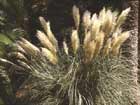
Pampas Grass
Scientific Name: Cortaderia selloana
Growth Habit: An upright perennial grass with long, narrow leaves with saw-toothed edges. Leaves are more than 1 inch wide and form plants growing to 8 feet tall and wide. Plantings produce tall plumes of white to pink inflorescences starting in August.
Light: Plant in full-sun to lightly shaded locations.
Feedings: Apply a 16-4-8 or similar lawn fertilizer once monthly in March and June.
Water Needs: Keep moist until established. Thereafter, it's a drought-tolerant plant usually surviving with moisture from seasonal rains.
Ease of Culture: Easy.
Propagation: Start plants with seed or by dividing older clumps.
Hardiness: Hardy.
Major Problems: Leaves may be damaged by chewing insects, but controls seldom are needed. Plantings develop root rot problems in wet soil; plant in a well-drained location. Older clumps develop open centers, and beds periodically have to be divided and reestablished.
Pruning: Ornamental grasses make the best growth with yearly renewal prunings. Trim back all shoots to within 12 to18 inches of the soil in January or February. Weak stems and older flower heads can be removed as needed.
Uses: Pampas grass ushers in the fall season with colorful plumes of flowers starting in late summer. The inflorescences can remain attractive through December and often are cut for dried arrangements. Cluster several plants as an accent, view barrier or space divider. Plant in low-maintenance landscapes and drought-proof designs.
Florida Native: No; native to South America.
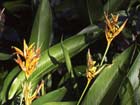
Parakeet Flower
Scientific Name: Heliconia psittacorum
Growth Habit: An upright perennial growing to 4 feet tall and 2 feet wide. The leaves are bright green and oblong. They arise from short stems and grow to 2 feet long and 4 inches wide.
Light: Plant in full sun to light shade.
Feedings: Apply a general garden fertilizer every six to eight weeks March through November for in-ground plantings. Feed container-grown plants every other week with a 20-20-20 solution or use a slow-release fertilizer as instructed on the label.
Water Needs: Prefers a moist soil; grows best if watered every three to four days during hot, dry weather.
Ease of Culture: Easy.
Propagation: Start plants by division of older clusters.
Hardiness: Tender; damaged by freezing conditions but usually grows back from rhizomes protected by a mulch.
Major Problems: Rhizomes might rot during wet, cool winters. Reduce watering during winter months when plants are affected by cold. Scale insects and leaf spot fungal organisms also might affect plants but seldom need control.
Pruning: Remove old flowers as they fade during the growing season to keep the plants attractive. Groom the plants in late February to remove all cold-damaged stems to the ground.
Uses: An attractive accent for perennial beds and tropical plant collections. Flowers are produced in an inflorescence with yellow, orange and red portions dependent on the variety (Andromeda is pictured). These colorful displays are produced May through November and often are said to resemble birds in flight as they are held above the foliage. Heliconia also can be grown in containers to display on patios, balconies and at entrances. The inflorescences are long lasting and often cut for use in flower arrangements.
Florida Native: No; native to Brazil.
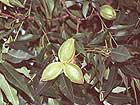
Pecan
Scientific Name: Carya illinoensis
Growth Habit: An upright tree when young, assuming a rounded shape with age; grows to more than 75 feet tall and wide. The leaves are deciduous, being compound and composed of lancelike leaflets growing to 6 inches long.
Light: Plant in full-sun locations.
Feedings: Needs a yearly feeding for good nut production. Apply a pecan fertilizer in February.
Water Needs: Drought tolerant; water frequently when young to help develop the extensive root system. Established shade trees usually exist with seasonal rains; fruit-producing trees grow best with weekly waterings during dry weather.
Ease of Culture: Medium; new trees need considerable care to become established.
Propagation: New trees can be started from seeds or by grafting known varieties on seedling root stocks.
Hardiness: Hardy.
Major Problems: Pests are a common problem, including leaf spots and caterpillars. The trees are too big for most home spraying, and the leaf blemishes are usually tolerated. Squirrels feed in the trees and consume most nuts, limiting home production.
Pruning: Keep young pecans to a central leader to grow tall shade trees for the landscape. Pecan trees can be kept smaller by cutting back the longer limbs to encourage branching and a more compact and often sturdier growth habit.
Uses: Most gardeners think of pecan nuts when considering these trees, but the trees also provide good shade. Plant in a landscape with plenty of room for a large tree and select varieties Curtis, Desirable and Moreland for good nut production.
Florida Native: No; native to other central and eastern states.
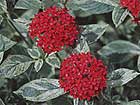
Pentas
Scientific Name: Pentas lanceolata
Growth Habit: An upright to rounded evergreen perennial growing to 5 feet tall and about as wide. Leaves are lancelike and solid dark green to variegated growing to 6 inches long and 2 inches wide.
Light: Plant in full sun to lightly shaded locations.
Feedings: Apply a general garden fertilizer to in-ground plantings every other month, March through December; feed container plants every other week with a liquid fertilizer solution.
Water Needs: Drought tolerant but grows best with weekly waterings.
Ease of Culture: Easy.
Propagation: Start plants with cuttings.
Hardiness: Tender; normally grows back from buds protected near the ground.
Major Problems: Grow in a well-drained soil to avoid root-rot problems. Chewing insects may feed on the foliage but seldom need control.
Pruning: Taller-growing selections often need pruning to remain in bounds and form compact plants. Trim out cold-damaged shoots and reshape plants at the end of February.
Uses: Pentas flower year-round, opening clusters of red, pink, lavender or white blossoms except when damaged by cold. They attract hummingbirds and butterflies to the landscape. Cluster several plants in an annual or perennial garden to form an accent or use them as a backdrop for other colorful plantings. Plants also can be added to containers for display at entrances or on patios and balconies.
Florida Native: No; native to Africa.
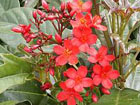
Peregrina
Scientific Name: Jatropha integerrima
Growth Habit: An evergreen shrub with multiple trunks growing up to 10 feet tall and wide. The leaves are deep green and variable in shape but mainly ovate with deep lobes and grow up to 6 inches long and 3 inches wide.
Light: Grow in a full-sun to lightly shaded location.
Feedings: Apply a general garden fertilizer once monthly in March, June and September if needed for growth.
Water Needs: Drought tolerant; water frequently until well-rooted in surrounding soil. Thereafter, seasonal rains normally provide adequate moisture.
Ease of Culture: Easy.
Propagation: Start plants from seeds or cuttings.
Hardiness: Tender; damaged by frosts and freezes but usually grows back from buds near the ground.
Major Problems: Scale insects and mites can damage the stems and foliage. Control with a low-toxicity oil spray as needed. Leaf miners also might affect foliage but seldom need control.
Pruning: Remove cold-damaged portions and reshape plants during late February. Control vigorous shoots during the growing season as needed to keep a compact and in-bounds shrub.
Uses: Plant as an accent near patios and as a feature in major garden displays. Can be trained to tree forms to use in background plantings or as focal points. Plants also can be added to large containers. Peregrina can bloom year-round, opening terminal clusters of bright-red flowers. Lower-growing and more-compact forms are available. Keep away from small children because all parts are poisonous.
Florida Native: No; native to Cuba.
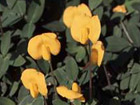
Perennial Peanut
Scientific Name: Arachis glabrata
Growth Habit: An evergreen perennial ground cover growing to 12 inches tall and 3 feet wide from underground rhizomes. The leaves are compound, consisting of three leaflets each growing to 1 1/2 inches long and an inch wide.
Light: Prefers full sun but tolerates light shade.
Feedings: Minimal feedings are needed to establish and maintain the plantings. No fertilizer is needed at planting. Thereafter a potassium-only fertilizer can be scattered over the planting in April and again during July if needed to encourage vigor and blooming. A magnesium sulfate also can be applied to increase the green leaf color during the growing season.
Water Needs: Very drought tolerant. Keep moist until the plantings become established; thereafter, survives with seasonal rainfall.
Ease of Culture: Easy.
Propagation: Plantings are started by dividing rhizomes or digging plugs dug from plants 5 years old or older. The best time to establish plantings is during early spring.
Hardiness: Tender; stays green until damaged by frosts or freezes but grows back from buds near or below the ground.
Major Problems: Weeds might invade newly established plantings. Control weeds in the planting site with Roundup, Finale or a similar herbicide before adding the perennial peanut. Remove weeds by hand during establishment or apply properly labeled herbicides. Plants grow vigorously and must be removed periodically from nearby areas.
Pruning: Plantings can be mowed as needed to a 4-inch height during the growing season to maintain a compact growth habit and to encourage flowering. Many gardeners mow only once in midsummer and again before frost.
Uses: Perennial peanut is an attractive ground cover to use anywhere in the landscape but especially where a low-maintenance drought-tolerant planting is needed. Much recent use is as a lawn substitute. Plantings open yellow blossoms above the foliage April through September. Varieties Arblick and Ecoturf maintain a compact growth habit and are commonly used as ground covers.
Florida Native: No; native to Argentina, Brazil and Paraguay.
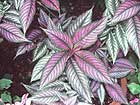
Persian Shield
Scientific Name: Strobilanthes dyeranus
Growth Habit: A rounded multistemmed evergreen shrub growing to 5 feet tall and wide. The leaves, green with silver and purple markings, grow to 8 inches long and 3 inches wide.
Light: Plant in shade to filtered-sun locations.
Feedings: Apply a general garden fertilizer to in-ground plantings once monthly in March, June and September. Feed container plantings with a slow-release fertilizer as instructed on the label.
Water Needs: Prefers a moist soil; in-ground plantings grow best if watered at least weekly during hot, dry growing conditions. Water container plants when the surface soil begins to dry.
Ease of Culture: Easy.
Propagation: Start plants from cuttings.
Hardiness: Tender; move container plants to warm locations and cover in-ground plantings to protect from frosts and freezes.
Major Problems: Caterpillars and beetles may occasionally chew holes in the foliage but seldom need control. Mites also cause yellowing of the leaves and can be controlled with soap or oil sprays. Nematodes may affect the roots to reduce water and nutrient uptake and cause decline.
Pruning: The Persian shield grows long stems of foliage that produce an open growth habit unless the plants are trimmed to encourage branching. It's best to remove the tips of young shoots periodically to produce additional growth and fuller plants.
Uses: Feature as an eye-catching accent in the shady areas of the landscape near a patio or an entrance or along walkways. This is also an excellent plant for tropical theme gardens with colorful foliage and spikes of purple flowers forming on mature plants during the summer months. Plants in containers can be set on a patio or balcony and displayed in the home.
Florida Native: No; native to Burma.
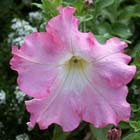
Petunia
Scientific Name: Petunia hybrida
Growth Habit: A sprawling annual with a rounded growth habit growing to 18 inches tall and 24 inches wide. The leaves are medium green and oblong to lancelike in shape and grow to 2 inches long and half as wide.
Light: Plant in a full-sun location for best flowering.
Feedings: Apply a general garden fertilizer once a month to encourage growth.
Water Needs: Prefers a moist soil; water at least weekly when the surface begins to dry.
Ease of Culture: Easy.
Propagation: Start plants from seed.
Hardiness: Hardy; tolerates light frosts but usually is damaged by a severe freeze.
Major Problems: Root-rot problems often occur when plants are overwatered or grown in the same location for several years. Alternate with other annual flowers to prevent the decline. Plants also may be affected by caterpillars, aphids and slugs, which can be controlled with natural products.
Pruning: Extend the flowering period by removing the declining blooms as noted. Petunias also become lanky as the plants develop long stems where blooms were present. These plants can be rejuvenated by trimming back the stems as needed to encourage growth.
Uses: Florida petunias are grown as cool-season annuals planted October through March to brighten beds, hanging baskets and planters. With good grooming, they can be enjoyed November through June as they open white, yellow, pink, red or purple blossoms that are more than 2 inches in diameter. Most are single-flowered types; double-flowered petunias are also available but are usually not as vigorous.
Florida Native: No; modern petunias are hybrids with ancestors from Argentina, Brazil and Uruguay.
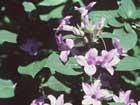
Philippine Violet
Scientific Name: Barleria cristata
Growth Habit: An upright to rounded evergreen shrub growing to 6 feet tall. The leaves are deep green and oblong growing to 4 inches long and 2 inches wide.
Light: Grows in shade to full-sun locations; flowers best at the higher light levels.
Feedings: Apply a general garden fertilizer once each month in March, June and September.
Water Needs: Tolerates short periods of drought; grows best with weekly waterings.
Ease of Culture: Easy.
Propagation: Start plants from seeds or cuttings.
Hardiness: Tender; damaged by freezes but grows back from buds near the ground.
Major Problems: Plant in a well-drained soil to avoid root-rot problems. Chewing insects may damage foliage occasionally, but controls seldom are needed. Also check for scales and treat with an oil spray if needed.
Pruning: Develop a compact and low-growing plant by removing tip portions of new shoots from young plants to encourage branching. Provide major pruning in late February or March to remove cold damage and rejuvenate older shrubs. The shrubs do reseed freely and may have to be trimmed or pulled from nearby plantings.
Uses: Plant as a quick-growing accent shrub among foundation plantings, along walkways and in flower gardens. New plantings or those frozen to the ground sprout shoots that bloom June through December. The bell-shaped blooms up to 2 inches in diameter are available in pink, purple, white and blue, giving rise to another common name -- bluebell barleria. Plants also can be used for hedges, view barriers and container gardens.
Florida Native: No; native to India and East Indies.
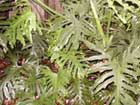
Philodendron Selloum
Scientific Name: Philodendron bipinnatifidum
Growth Habit: A sprawling evergreen shrublike perennial producing one or more thick stems and growing to 10 feet tall and wide. The dark green leaves are deeply divided and grow to 2 feet long and wide.
Light: Plant in full sun to light shade.
Feedings: Apply a general garden fertilizer once monthly in March and June.
Water Needs: Drought tolerant; grows best when watered every other week during periods of drought.
Ease of Culture: Easy.
Propagation: New plants are started from seeds or through tissue culture.
Hardiness: Tender; survives most winters with minimal leaf damage. When severely damaged, plants usually grow back from buds near the ground.
Major Problems: Plants prefer an acid soil and may yellow when growing in the alkaline conditions near homes and sidewalks. Adjust the pH or apply minor nutrients to correct the chlorotic look. Plants may also be affected by scale insects but seldom need control.
Pruning: Selloums grow rapidly and often need pruning to remain in bounds. Stem portions can be removed to limit growth. Major pruning is often performed at the end of winter to remove cold damage.
Uses: Single plants can be used as large accent features near patios and along walkways. Selloums also can be used as foundation plantings near large walls, but allow room for growth. Several can be lined up to create view barriers and space dividers. Plants also may be added to containers for patio and balcony displays. The flowers are contained in a green to cream-colored bananalike inflorescence that is a curiosity but often hidden by the foliage.
Florida Native: No; native to Brazil.
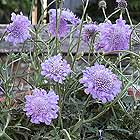
Pincushion Flower
Scientific Name: Scabiosa caucasica
Growth Habit: A low-growing evergreen perennial, treated as an annual in Florida; forms a rosette of foliage up to 10 inches tall and wide; flower stalks are leafless and grow to 18 inches tall. The leaves are deep green and fernlike, growing to 6 inches long and an inch wide.
Light: Plant in full sun to lightly shaded locations.
Feedings: Apply a general garden fertilizer to in-ground plantings once a month; feed container plantings with a 20-20-20 or similar fertilizer every other week. Slow-release fertilizers also may be applied as instructed on the label.
Water Needs: Grow in a moist, well-drained soil; water when the surface begins to feel dry.
Ease of Culture: Easy.
Propagation: Plants are started from seed and by division of mature clumps; Florida gardeners normally purchase plants in bloom.
Hardiness: Hardy.
Major Problems: Plants decline during hot, humid summers and are best replaced with heat-tolerant annuals or perennials. Chewing insects and slugs may damage the foliage but can be handpicked as needed.
Pruning: Remove faded flower clusters along with the long stalks back to near the ground to encourage additional blooms.
Uses: A colorful, temperate-climate perennial best known for its blue or purple flower clusters opening to 3 inches in diameter; pinks and whites are also available. Purchase plants during spring to add to flower beds and container gardens, and enjoy until the hot, humid days of summer. Plantings in sites with morning sun and afternoon shade often last the longest. Pincushion flowers attract butterflies and can be cut for bouquets.
Florida Native: No; native to the Caucasus Mountains.
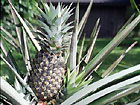
Pineapple
Scientific Name: Ananas comosus
Growth Habit: An evergreen perennial with upright to arching dark-green to blue-green leaves arising from a basal stem and growing to more than 3 feet tall. The lancelike leaves are often edged with spines and grow to 3 feet long and 2 inches wide.
Light: Plant in full-sun to shaded locations. Best fruiting is obtained in the sunny sites.
Feedings: Apply a general garden fertilizer monthly March through November to encourage growth and fruiting. No fertilizer is needed during the winter months.
Water Needs: Drought tolerant. Can exist with moisture from seasonal rains; grows and fruits best with weekly waterings during periods of drought.
Ease of Culture: Easy.
Propagation: Most gardeners start plants from tops saved from pineapple fruits stuck in containers of potting soil. Plants also can be started from offshoots.
Hardiness: Tender but survives most winters to fruit the following spring. If severely damaged, usually grows back from buds near the ground.
Major Problems: Tolerant of most pests, but can be affected by scale insects and nematodes. Controls are seldom needed in the home landscape. Also plant in well-drained soil to avoid root rot problems.
Pruning: Trim declining leaves after winter to remove cold damage. Plants that have produced a fruit gradually decline and may also be removed as needed. Trim the prickly leaves away from walks to avoid injuries.
Uses: Gardeners are intrigued by pineapples and often add one or more to the landscape or container gardens. They serve as a garden accent or can be used along walks and on patios. Plants produce a pink-and-green inflorescence with many purplish flowers that form the fruit. Pineapple fruits turn a yellowish to orange color and are ready to pick about five months after flowering.
Florida Native: No; native to Brazil.
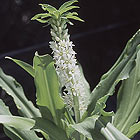
Pineapple Lily
Scientific Name: Eucomis punctata
Growth Habit: An upright-growing lily that sprouts shoots from an underground bulb and grows to 2 feet tall. The leaves are straplike and bright green and grow to 2 feet long and 2 inches wide.
Light: Plant in full sun to lightly shaded locations.
Feedings: Apply a garden fertilizer to plants in the ground in March and June; feed container plantings lightly every other week March through September.
Water Needs: Needs a moist soil; water when the surface begins to feel dry.
Ease of Culture: Medium; extra care is needed to grow and flower.
Propagation: Start plants from seeds or by dividing older clumps.
Hardiness: Hardy.
Major Problems: Leaf-chewing insects may feed on the foliage. Control by handpicking if needed.
Pruning: Trim declining leaves and flowers as needed during the growing season. Remove all browning foliage when the bulbs go dormant for the fall and winter months.
Uses: An accent plant for the perennial garden or a container planting. The bulbs also may be set in clusters of three or more along walkways or mixed with low-growing shrubs. White to yellow star-shaped flowers form along a foot-tall stem topped with a cluster of green foliage. Some gardeners think the flowering stems resemble a fruiting pineapple plant, which gives rise to the common name. Plants are in bloom May through August. Keep container-grown plants with foliage collections or set out with shrubs in the landscape and keep moist when not in bloom. Keep on the dry side when dormant.
Florida Native: No; native to South Africa.
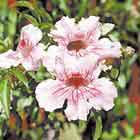
Pink Trumpet Vine
Scientific Name: Podranea brycei
Growth Habit: A sprawling evergreen vine with shoots growing to 15 feet in length. The leaves are pinnately compound with leaflets having shallow-toothed margins.
Light: Can be planted in light shade, but flowers best in full sun.
Feedings: Encourage growth as needed with feedings of a general garden fertilizer once each month in March, June and October.
Water Needs: Tolerates short periods of drought; grows best when watered at least every week.
Ease of Culture: Easy.
Propagation: Start new plants from seeds and cuttings.
Hardiness: Tender; damaged by freezes but usually grows back from buds protected by mulch near the ground.
Major Problems: Plant in nematode-free soil to prevent root damage. Look for mites during the dry weather and scales anytime. Control mites and scale with an oil spray as needed.
Pruning: Train to a trellis or arbor. Keep in bounds by pruning immediately after flowering. Remove older declining stems and shoots.
Uses: Has clusters of pink blossoms with red veins and a yellow throat December through April and sporadically throughout the year. Use to disguise a wall or hide a building. Vines trained to trellises and arbors also can be used as space dividers and accent features.
Florida Native: No; native to south Africa.
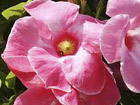
Pink Allamanda
Scientific Name: Mandevilla splendens
Growth Habit: An evergreen vine that grows vigorously during warmer weather. It can grow more than 15 feet tall and wide. The leaves are oblong and deep green and grow to 8 inches long and half as wide.
Light: Plant in a full-sun location.
Feedings: Feed lightly with a general garden fertilizer once monthly in April, July and September.
Water Needs: Keep moist until the roots grow into the surrounding soil. Considered drought-tolerant but grows best with weekly waterings during hot, dry weather.
Ease of Culture: Easy.
Propagation: Start plants from cuttings.
Hardiness: Tender; most local plantings die back during the winter months and resprout from buds near the ground during spring.
Major Problems: Nematodes can affect the roots. Plant in nematode-free soil. Plantings also can be affected by mealybugs and scale insects. Natural oil sprays might be needed when these pests are found.
Pruning: Remove all cold-damaged portions at the end of February and reshape the vines to prepare for spring growth. Train the vines to a trellis and pinch back the tips as needed to encourage branching and to produce compact growth.
Uses: Many gardeners like to train a pink allamanda, also called mandevilla, to a mailbox stand or a trellis near an entrance to enjoy the large, bright-pink, funnellike blooms opening July thorough September. Plantings can be used to conceal a wall or to create a view barrier. They also can be used in planters and hanging baskets. Central Florida residents should consider this a seasonal vine, because plantings develop yellow foliage and decline during the fall.
Florida Native: No: native to Brazil.

Pink Ball
Scientific Name: Dombeya wallichii
Growth Habit: A bushy, rounded, evergreen shrub with numerous widely spaced limbs growing to 20 feet tall and wide. The leaves are deep green, fuzzy and heart-shaped, growing to 12 inches long and wide.
Light: Grow in full sun to light shade.
Feedings: Apply a general garden fertilizer once monthly in March and June.
Water Needs: Tolerates short periods of drought; grows best with weekly waterings.
Ease of Culture: Easy.
Propagation: Start plants from cuttings.
Hardiness: Medium; damaged by severe freezes but grows back from buds near the ground.
Major Problems: Scale insects can affect the foliage and stems. Aphids also may feed in the growth. Both can encourage the sooty mold fungus to form a black film on the surface of leaves. An oil spray can be applied to control the insects and sooty mold as needed. Also grow the plants in a nematode-free soil.
Pruning: Plants can be rampant growers and can benefit from a late February or March pruning when flowering is over. Remove cold-damaged limbs and reduce the size of the shrubs by one-half or more at this time.
Uses: This attractive winter-blooming shrub, also called the tropical snowball and hydrangea tree, produces 6-inch or larger pendant clusters of pink blossoms December through February. Plants can be added as an accent near patios and at the end of views or as a backdrop for gardens.
Florida Native: No; native to East Africa and Madagascar.
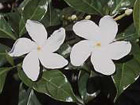
Pinwheel Flower
Scientific Name: Tabernaemontana divaricata
Growth Habit: A rounded, wide-spreading evergreen shrub with numerous branches growing to 8 feet tall and wide. The leaves are dark green with pronounced veins growing to 6 inches long and 2 inches wide.
Light: Plant in light shade to full sun.
Feedings: Apply a general garden fertilizer once in March, June and October.
Water Needs: Tolerates short periods of drought; grows best with weekly watering during hot, dry times.
Ease of Culture: Easy.
Propagation: Start plants from cuttings.
Hardiness: Tender; damaged by freezing temperatures but grows back from buds near the ground.
Major Problems: Scale insects might affect the foliage and stems to cause yellowing and reduced plant vigor. This feeding encourages growth of the black sooty mold fungus. Control both pests with a natural oil spray available from your garden center.
Pruning: Perform major pruning in late February to remove cold damage and to reshape plants as needed. Out-of-bounds shoots can be removed at any time during the growing season.
Uses: Plant as a backdrop for gardens or lower-growing shrubs. It also can be used to create a natural hedge between sections of the landscape and at property lines. Plants can be added to larger containers or trimmed to become small trees. Clusters of white blossoms open year-round and resemble a pinwheel; they also might look like single-flowered gardenias. The blossoms have a carnationlike fragrance, especially during the evening.
Florida Native: No; native to India and Thailand.
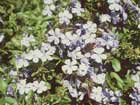
Plumbago
Scientific Name: Plumbago auriculata
Growth Habit: A rounded to sprawling evergreen shrub growing to 6 feet tall and wide. The leaves arelancelike and a light to medium green color, growing to 2 inches long and an inch wide.
Light: Plant in full-sun locations.
Feedings: Apply a general garden fertilizer once monthly in March, June and September if needed for growth.
Water Needs: A drought-tolerant plant usually surviving with water from seasonal rains.
Ease of Culture: Easy.
Propagation: Start plants from cuttings.
Hardiness: Medium; damaged by severe freezes but grows back from buds on stems near the ground.
Major Problems: Fungal leaf spotting and stem decline may be noted during the wetter months, especially in areas with poor air movement. Fungicides can be used for control. Scale insects and mites are occasional pests and can be controlled as needed with natural oil sprays.
Pruning: Plumbago can become a rampant grower. Keep plants in bounds and renew the stems with late winter prunings as needed to control growth and remove cold damage. Plants may need additional trimming during the growing season.
Uses: A good plant for the poor and dry soils. Use as a foundation planting, a hedge or a backdrop for lower-growing shrubs, flower gardens and ground covers. The preferred flower color is deep blue, but selections of light blue to white are also available. Plantings produce clusters of flowers above the foliage year-round unless they are affected by cold.
Florida Native: No; native to South Africa.
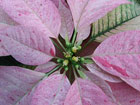
Poinsettia
Scientific Name: Euphorbia pulcherrima
Growth Habit: An evergreen shrub with multiple widely spaced stems growing to 8 feet tall and wide. The leaves are deep green, ovate in shape, often with broadly toothed edges; they grow to 8 inches long and half as wide.
Light: Plant in full sun for best flowering; also grows in light shade.
Feedings: Apply a general garden fertilizer every other month March through November.
Water Needs: Tolerates short periods of drought but grows and looks best when watered weekly during periods of drought.
Ease of Culture: Easy.
Propagation: Start plants from cuttings.
Hardiness: Tender; survives most winters. When damaged by frost and freezes, the plant usually grows back from buds protected by mulch near the ground.
Major Problems: Hornworm caterpillars chew holes in the leaves; poinsettia scab cause stems to become bumpy and twisted; and mites cause leaves to yellow during the warmer months. All can be controlled with natural pesticide treatments as needed.
Pruning: Trim landscape plantings to within 12 to 18 inches of the ground during early March. Then, when plants form a foot of new growth, remove 4 inches from the top of each shoot. Repeat after each flush of growth through August to produce a compact multistemmed plant.
Uses: Use single plants or clusters of poinsettias as a backdrop for gardens, part of the foundation planting or as a feature along walkways. Plants also can be grown in containers to create holiday displays on patios and balconies or at entrances. Red-bracted forms are the most popular but white, pink, orange and blends of several colors are also available for November through March displays. Plants develop seasonal color only when they receive natural daylight and no nighttime light during the fall.
Florida Native: No; native to Mexico.
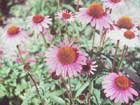
Purple Coneflower
Scientific Name: Echinacea purpurea
Growth Habit: A short-lived upright evergreen perennial growing to 3 feet tall in gardens. Leaves are medium green, toothed and lancelike, growing to 6 inches long and 2 inches wide.
Light: Plant in full sun to light shade.
Feedings: Apply a general garden fertilizer once monthly in March, June an August.
Water Needs: Tolerates short periods of drought; grows best with a light mulch and weekly waterings.
Ease of Culture: Easy.
Propagation: Start from seed.
Hardiness: Hardy.
Major Problems: Plants may be affected by chewing insects but seldom need control. Slugs also may feed on the foliage and can be handpicked or controlled with a natural slug bait.
Pruning: Remove faded blooms to encourage additional flowers throughout the growing season. Also rejuvenate clumps during late February by trimming declining stems to just above the green foliage near the ground.
Uses: Cluster clumps of three to five coneflowers in perennial beds, butterfly gardens and along walkways to enjoy tall stems topped with flower clusters consisting of reddish-purple outer blooms and brownish inner blossoms. Plantings flower May through October. The flowers attract butterflies, and if the seed heads are left, they provide food for birds. Stalks of flowers also can be cut for bouquets.
Florida Native: Yes.